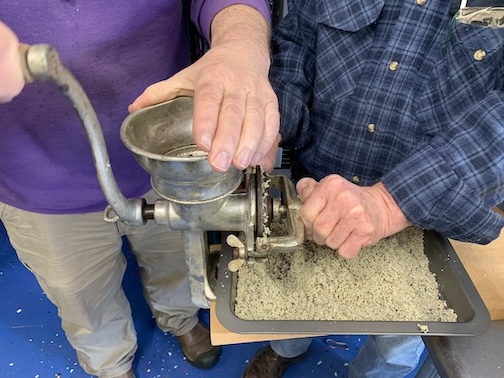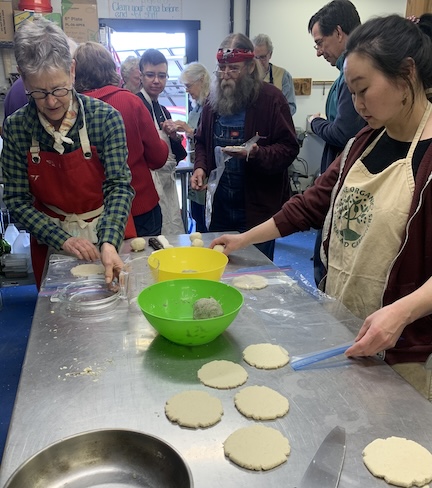Introduction and photos by Jean English; Recipes by Dusty Dowse
On April 13, 2024, the MOFGA-El Salvador Sistering Committee and the Maine Grain Alliance (MGA) held a hands-on workshop at MOFGA about corn and pupusas.
Sistering committee member Karen Volckhausen began the event, noting that most sistering relationships pair a city in one country with a city in another, but MOFGA’s committee partners with two MOFGA-like organizations in El Salvador: CCR, the Association of Communities for the Development of Chalatenango; and CORDES, the Foundation for Communal Cooperation and Development of El Salvador. The partnership began in 2001 to create solidarity among small farmers and community organizations in Maine and El Salvador; to promote economic and social justice and environmental protection through sustainable, organic agriculture and sustainable communities; to put a human face on the impact of globalization; and to enable farmers and gardeners in each country to learn from one another.
The committee meets monthly, Zooms regularly with its Salvadoran partners, hosts delegations to El Salvador, holds workshops, and hosts visitors from El Salvador. It is part of the national U.S.-El Salvador Sister Cities Network (elsalvadorsolidarity.org).
Volckhausen noted that the committee’s relationship with its sistering committees continues to be important as El Salvador’s authoritarian president enacts policies that, while cutting gang activity drastically, also threaten citizens’ rights.
About Corn
Dusty Dowse of the MGA (and a well-known baker at the Common Ground Country Fair) discussed the incarnations of corn. The crop has been around for about 10,000 years and was considered very spiritual long ago, as evidenced by the Seminole tribe’s green corn dance. But “something happened to corn,” said Dowse, as it became industrialized, genetically engineered, and used for animal feed and ethanol production. The MGA “is trying to get it back to where it and other grains were” before they became so industrialized, he said.
Scientists spent decades trying to trace the origin of corn, and molecular genetics eventually showed that it came from Teosinte (Zea mays subsp. parviglumis) with a generous addition of Z. mays mexicanum. Carbon isotope ratios show that it was eaten in Oaxaca, Mexico, 7,000 to 9,000 years ago.
As people raised corn for different reasons in different areas, they selected flint, flour, dent or “field,” sweet corn, and popcorn. The crop is used in polenta, corn bread, corn flakes, Johnny cakes, popcorn, and many other dishes.
About 3,500 years ago, people found that it was easier to make tacos and other products if the hull was removed from the corn grain. One way to do this was to boil it by burning a hole in a hardwood log, filling the hole with water and corn, heating rocks in a fire, and then placing them in the water. The Mayans, who had lime kilns, added to the process by “nixtamalizing” corn — boiling corn dough (“tamalli”) in water containing lime ashes (“nextli”), which are calcium hydroxide. Nixtamalizing improves the flavor and consistency of the dough; breaks down some corn oil into emulsifying agents; binds proteins; makes niacin (vitamin B3) available, countering pellagra (niacin deficiency); increases the calcium content of the grain; and reduces phytic acid, which can interfere with the absorption of some minerals. Nixtamalizing also reduces or eliminates aflatoxins (toxins produced by fungi that sometimes infect corn).
Corn was interplanted with squash and beans in the traditional “milpa system” to provide adequate protein.
Dowse provided recipes for nixtamalizing dried corn to use in pupusas, as well as recipes using masa harina flour (nixtamalized and ground corn available in most grocery stores and food coops).
Saving Heritage Grains
Next, Richard Roberts reviewed MGA’s 10 years of restoring and preserving heritage grains. Maine farmer Will Bonsall initially showed MGA members how to grow grains. Roberts works primarily with wheat, using seeds obtained from Bonsall, the Seed Savers Exchange, seed saver Eli Rogosa, and others. But Roberts did bring seed of the heritage Byron corn to share. He noted that MGA and MOFGA both have equipment to loan for grain growing and that both organizations grow grains at the former Kennebec Valley Community College farm in Hinckley — including using a “maslin” system in which many varieties grow in the same field at the same time to produce a multigrain population.
After introductory talks, the 15 workshop participants gathered in MOFGA’s kitchen to grind corn, make pupusa dough, add filling to the dough, and then form the dough into a flat circle around the filling. Then they cooked the pupusas on a griddle and enjoyed the results with salsa and curtido.
Recipes
Masa from Scratch: The Nixtamalization Process
Dried corn — flour, dent, flint, or even popcorn — all work, but boiling times vary. Flint, the hardest as its name implies, takes about an hour, while dent takes as little as 20 minutes. Test the corn as it boils. It should be soft but not losing its integrity.

- 2 lbs. corn
- 3 quarts water (enough to cover kernels by about 2 inches; they must remain under the liquid overnight as water is absorbed)
- ¼ cup slaked lime (calcium hydroxide)
- 2 tsp. salt (optional)
Bring water to a boil in a nonreactive (preferably stainless steel) pot and slowly add lime while stirring. Stir in well-washed corn. Bring the resulting thick white slurry to a strong boil and stir for a minute or so. Reduce heat to a simmer and hold for about 20 minutes to 1 hour, depending on the type of corn. Let the pot cool. Refrigerate or let stand at ambient temperature overnight. The mix must sit for at least 8 hours; 10 is better.
After steeping, wash the lime thoroughly from the corn. Six or seven changes of water should do. Work the corn in a colander with your hands to remove the skins while washing and draining the corn. Keep floating off the skins but leave some hulls to sustain the cohesiveness of the masa. The finished product will look shiny and clean. Thoroughly rinse off all wash water.
Grind the boiled and softened corn in a mill to yield a thick, smooth paste. Add water sparingly and only if you must. Knead in 2 tsp. of salt and work until the dough is homogenous.
Starting from Masa Harina Flour
- 2 cups masa harina flour
- 1 ½ cups warm water (Adjust as needed up to about 2 cups)
- ½ tsp. salt
Mix ingredients until smooth and cohesive. Slowly and systematically add water if the dough remains dry and crumbly. Add flour if the dough is sticky or too gummy. Let the dough sit for about 20 minutes to hydrate fully. It should be pliable and elastic but not sticky. Pupusas will crack badly if the dough is too dry.

Making the Pupusa
Among the many techniques for making pupusas from masa, this one suits beginners.
Cut the mixed and hydrated dough into equal portions and form each into a ball. The masa harina recipe above makes eight balls. Let the balls rest under a moist dish towel. Place a ball on a cut plastic food storage bag and press it into a 4-inch diameter circle. Place a small amount of filling (refried beans with or without cheese) in the center of the circle, pull up the sides like a dumpling, and seal the edges. Then press the filled ball to make a 4-inch circle again. Bake the pupusa on a lightly oiled griddle or in a frying pan on medium-high heat for about three minutes per side, depending on the stove and griddle. When dark spots form on the pupusa, it is ready.
Curtido — Quick Version
- ½ head finely shredded cabbage
- ½ very thinly sliced red onion
- 2 finely shredded carrots
- 1 fresh, sliced jalapeño pepper (optional)
- boiling water
- ½ tsp. dried oregano
- Salt to taste
- ½ cup white or apple cider vinegar
Bring 4 cups water to a boil. Place cabbage in a fine mesh strainer. Very slowly pour boiling water over the cabbage. Rinse with cold water. Drain well, pressing out as much water as possible.Place cabbage in a large bowl. Add carrot, onion, pepper, oregano, and vinegar and toss well or cover the bowl with a lid and shake it.Curtido tastes best after marinating for several hours or days, but you can also enjoy it fresh. Store curtido in a covered container or mason jar for up to one week in the fridge.
Curtido — Fermented Version
Makes about 6 cups.
If you’re new to fermenting, this recipe is a good place to start as it pickles quickly and easily. You can taste the difference in flavor every day, and the longer this relish ferments, the better it tastes. It’s great fresh, but by day three you’ll taste the difference. The salty brine becomes tangier as it sits, so you may not need to add vinegar.
- ½ large head cabbage, thinly sliced
- 3 medium carrots, grated on the large holes of a box grater
- ½ large white onion, thinly sliced
- 2 serrano chiles, thinly sliced
- 1 garlic clove, finely grated
- 2 tsp. dried oregano, preferably Mexican
- 5 tsp. salt
- ¼ cup extra-virgin olive oil
- Apple cider vinegar (for serving)
Toss together the first seven ingredients in a large bowl. Let sit for 30 minutes for cabbage to wilt. Transfer to an airtight container and press down firmly on cabbage to release juices; liquid should be at or above the level of the vegetables. Tightly cover the curtido and let it sit at room temperature for one to five days, tasting daily until you like the flavor. Just before serving, drizzle oil into the curtido and toss to combine. Taste and season with vinegar and more salt if needed. Curtido can be made one week ahead. Chill after you have added the oil and vinegar.
This article originally appeared in the winter 2024-2025 issue of The Maine Organic Farmer & Gardener.
